- Explore the playful behavior of wolverines Sid and Ahmari in the snow and its significance for understanding animal behavior in captivity.
- Discuss the species-specific adaptations of wolverines that enable them to thrive in cold climates.
- Highlight the importance of zoo environments like the one managed by Assistant Curator Allyson in promoting well-being and natural behaviors in captive wildlife.
- Explain the broader context of wildlife conservation efforts centered around wolverines.
- Provide insights into the role of zoos in educating the public and contributing to conservation science.
Wolverines Sid and Ahmari recently delighted onlookers by frolicking in the snow, offering a glimpse into their unique behaviors. This play is not merely recreational; it offers insights into the very fabric of animal behavior, especially within captive environments. In these controlled yet nature-mimicking habitats, observing wolverine activities helps highlight the nuances of their social interactions and physical abilities. Such behavioral studies are invaluable for zoologists aiming to ensure the well-being of wolverines in captivity, reflecting broader concerns of wildlife conservation.
Wolverines are magnificent creatures specifically adapted to thrive in frigid environments. Their stocky build, dense fur, and wide, snowshoe-like paws enable them to travel across snow with agility and ease. These adaptations are not just for survival; they empower wolverines to be dynamic hunters and foragers, capable of covering vast distances in search of food. By observing Sid and Ahmari in the snow, researchers can study how these physical traits are utilized in a captive setting, informing practices to enhance their living conditions.
The efforts of zoo professionals, such as Assistant Curator Allyson, are paramount in creating enriched environments that simulate the wild habitats of these species. These environments strive to satisfy the wolverine’s need for physical activity and mental stimulation, which are critical for preventing the development of neurotic behaviors often observed in captivity. The curated settings allow Sid and Ahmari to exhibit natural behaviors, such as scent marking or caching food, providing valuable data on their habits and preferences.
On a larger scale, understanding these behaviors supports conservation efforts for wolverines, whose natural populations face numerous threats, including habitat loss and climate change. By maintaining captive breeding programs and sanctuary habitats, zoos contribute to conservation science by preserving genetic diversity and researching solutions to challenges in the wild. The playful snowbound antics of Sid and Ahmari are more than an amusing spectacle; they are a small part of a comprehensive conservation strategy.
Zoos play a crucial role in public education, helping people connect with and understand wildlife. Through observing animals like wolverines, visitors gain an appreciation for their adaptations and the conservation challenges they face. Educational programs and guided tours further emphasize how human actions impact wildlife, inspiring stewardship and support for conservation initiatives. This educational aspect underlines the significance of institutions in shaping public attitudes towards biodiversity preservation.
In conclusion, Wolverines Sid and Ahmari’s snowy play is both a testament to the intricate behaviors of these fascinating animals and a reflection of the complex roles zoos play in wildlife conservation and public education. These interactions between zoo environments and their inhabitants offer crucial insights, fostering a deeper understanding that benefits both animals in captivity and their wild counterparts.
*****
Source Description
Wolverines in Snow: a short story❄️
📸Wolverines Sid and Ahmari play in snow. Thank you Assistant Curator Allyson for the photos!


